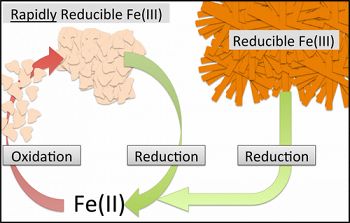Ginn et al., 2017
Rapid iron reduction rates are stimulated by high-amplitude redox fluctuations in a tropical forest soil
Ginn, Brian, Christof Meile, Jared Wilmoth, Yuanzhi Tang, and Aaron Thompson (2017)
Environmental Science & Technology 51 (6): 3250-3259
-
Luquillo, GRAD STUDENT
-
Calhoun, Luquillo, INVESTIGATOR, COLLABORATOR
Abstract
Iron oxides are important structural and biogeochemical components of soils that can be strongly altered by redox-driven processes. This study examined the influence of temporal oxygen variations on Fe speciation in soils from the Luquillo Critical Zone Observatory (Puerto Rico). We incubated soils under cycles of oxic-anoxic conditions (τoxic:τanoxic = 1:6) at three frequencies with and without phosphate addition. Fe(II) production, P availability, and Fe mineral composition were monitored using batch analytical and spectroscopic techniques. The rate of soil Fe(II) production increased from ∼3 to >45 mmol Fe(II) kg–1 d–1 over the experiment with a concomitant increase of an Fe(II) concentration plateau within each anoxic period. The apparent maximum in Fe(II) produced is similar in all treatments, but was hastened by P-amendment. Numerical modeling suggests the Fe(II) dynamics can be explained by the formation of a rapidly reducible Fe(III) phases derived from the progressive dissolution and re-oxidation of native Fe(III) oxides accompanied by minor increases in Fe reducer populations. The shift in Fe(III) reactivity is evident from Fe-reducibility assays using Shewanella sp., however was undetectable by chemical extractions, Mössbauer or X-ray Absorption spectroscopies. More broadly, our findings suggest Fe reduction rates are strongly coupled to redox dynamics of the recent past, and that frequent shifts in redox conditions can prime a soil for rapid Fe-reduction.
Citation
Ginn, Brian, Christof Meile, Jared Wilmoth, Yuanzhi Tang, and Aaron Thompson (2017): Rapid iron reduction rates are stimulated by high-amplitude redox fluctuations in a tropical forest soil. Environmental Science & Technology 51 (6): 3250-3259. DOI: 10.1021/acs.est.6b05709
 This Paper/Book acknowledges NSF CZO grant support.
This Paper/Book acknowledges NSF CZO grant support.
Explore Further



